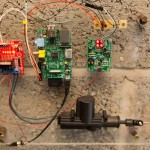With the increase in the amount of data taken up by images on my PC data throughput has become a real problem. Dozens of seconds to load and save files, not to mention 25 seconds to open Photoshop. Each image I take of my camera is 25-30MB, and when I am working on a file, it can be 600-800MB for a few days until I’m happy with it and compress it down to a flattened image at about 100MB. Loading and saving these files can take up to a minute on my PC.
I started looking into increasing the performance of editing images on my PC. The main prompt was the fact that my 1TB drive in my pc crashed (I had 3 backups so nothing lost). I took a look at what the main bottlenecks were, and it seemed that disk speed was one of the main problems. Having discussed RAID systems in a previous post, I thought I’d investigate setting up a striped array as a second drive on my desktop. Striping allows two disks to be “merged” showing up as 1 disk to windows, but the underlying writes are spread across each disk, theoretically doubling the read/write performance.
First of all I discovered that Windows 7 now includes software RAID, and the benchmarks on the web showed that the speeds were very similar to the motherboard RAID solutions for both RAID 1 and RAID 0 (Mirroring and Striping), so I had a go at that. Well into the process of copying about 800GB of data around the place to make two spare drives, I found that only Windows 7 Professional and Windows 7 Ultimate allow RAID configurations. I’ve got Windows 7 Home Premuim, which DOES NOT have RAID functionality. Bummer.
Then I took a closer look at my motherboard, and it has a RAID controller built in. But there was a problem, I couldnt enable the RAID controller in the BIOS without causing my current windows installation to give me a BSOD (Blue Screen of Death) at boot. Even the solution suggested by Microsoft didnt help, so I freed up another 500G SATA drive and installed a fresh copy of Windows 7 on it, after enabling the RAID controller on the motherboard. It was very particular about the BIOS settings to get windows recognising the SATA CD-ROM drive and the hard disk. Anyway, once I got the settings right, I installed Windows and the nVidia RAID software.
Then, I installed my two 1TB drives (Seagate Baracuda 7200.12’s, €80 each in Maplin), and kicked off the nVidia storage manager. This is quite a neat piece of software that allows easy configuration of arrays based on spare disks in the system. I started a couple of self tests on the disks, which checked out healthy. I chose not to migrate any existing data, so the new striped array was created in seconds in the nVidia storage manger. Then using the Disk Manager in windows to create a couple of partitions on that disk, which again, took seconds, I started up the ATTO Disk Benchmark Utility. Previously I had tested the Seagate disks individually, giving me a max speed of about 125MB/sec. With the new striped array, this was increased to 247MB/sec! Success.
 ATTO Benchmark for Striped 1TB Seagate Baracuda 7200.12’s
ATTO Benchmark for Striped 1TB Seagate Baracuda 7200.12’s
Because it’s a striped disk, I need to be very careful to have a good backup policy, because if one of the disks in the array goes, I lose ALL the data. If youwant data security, dont use RAID 0 (striping).
Now to install Photoshop CS4, then the CS5 upgrade, and restore my photos onto it and see what kind of performance improvement I get in general use editing pictures. I don’t expect the actual processing to be much quicker. but organising images in bridge, generating previews, loading/saving large TIFFs should all be improved.
Once Photoshop was installed, I started it up, it took about 8 seconds. Closing and opening again took about 4 seconds. This is an improvement from about 25 seconds from cold with my old 80MB/sec boot drive.
Adobe bridge seems a lot snappier now, with previews loading much quicker. Also, I can now save a 1GB TIFF file in under 10 seconds. I reckon this will save me a several days over the course of a year 🙂
 (DISCLAIMER: Not meant as a security solution or a lesson in good dog behavior. It’s an experimental proof of concept to play with the application of embedded computing to solve particular use cases)
(DISCLAIMER: Not meant as a security solution or a lesson in good dog behavior. It’s an experimental proof of concept to play with the application of embedded computing to solve particular use cases) A
A